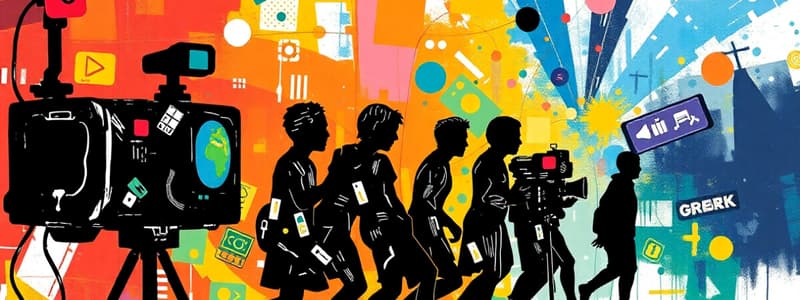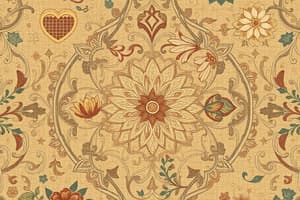Podcast
Questions and Answers
The concept of the Internet of Things (IoT) emerged in the early 1990s.
The concept of the Internet of Things (IoT) emerged in the early 1990s.
True (A)
The term "Internet of Things" or IoT was coined by ______, a co-founder of MIT's Auto-ID Center.
The term "Internet of Things" or IoT was coined by ______, a co-founder of MIT's Auto-ID Center.
Kevin Ashton
What is the primary purpose of connecting everyday objects to a computing device in the context of IoT?
What is the primary purpose of connecting everyday objects to a computing device in the context of IoT?
What are three key components typically embedded in IoT devices that enable communication and control?
What are three key components typically embedded in IoT devices that enable communication and control?
Signup and view all the answers
Match the following examples with their respective functionalities in the context of IoT:
Match the following examples with their respective functionalities in the context of IoT:
Signup and view all the answers
What invention is most notable during the Industrial Age?
What invention is most notable during the Industrial Age?
Signup and view all the answers
The Electronic Age started in the 1980s and ended in the 2000s.
The Electronic Age started in the 1980s and ended in the 2000s.
Signup and view all the answers
What was a significant change that occurred during the Information Age?
What was a significant change that occurred during the Information Age?
Signup and view all the answers
The earliest example of media discovered is _____ paint.
The earliest example of media discovered is _____ paint.
Signup and view all the answers
Match the following media ages with their notable inventions:
Match the following media ages with their notable inventions:
Signup and view all the answers
Which communication method was developed during the Industrial Age?
Which communication method was developed during the Industrial Age?
Signup and view all the answers
The invention of the transistor allowed for real-time communication.
The invention of the transistor allowed for real-time communication.
Signup and view all the answers
What period is characterized by the invention of the telephone?
What period is characterized by the invention of the telephone?
Signup and view all the answers
During the _____ Age, people began developing machine tools and establishing iron production.
During the _____ Age, people began developing machine tools and establishing iron production.
Signup and view all the answers
Which of the following represents changes related to the Electronic Age?
Which of the following represents changes related to the Electronic Age?
Signup and view all the answers
What does E-Governance primarily utilize to provide government services?
What does E-Governance primarily utilize to provide government services?
Signup and view all the answers
Digital media is completely different from traditional media in terms of content delivery.
Digital media is completely different from traditional media in terms of content delivery.
Signup and view all the answers
Name one social media platform that can be used to verify information.
Name one social media platform that can be used to verify information.
Signup and view all the answers
Government-to-citizen (G2C) offers citizens access to __________ services online.
Government-to-citizen (G2C) offers citizens access to __________ services online.
Signup and view all the answers
Match the following types of E-Governance with their definitions:
Match the following types of E-Governance with their definitions:
Signup and view all the answers
How did the industrial age impact media roles in society?
How did the industrial age impact media roles in society?
Signup and view all the answers
Digital media is less interactive compared to traditional media.
Digital media is less interactive compared to traditional media.
Signup and view all the answers
What can be catastrophic when misused?
What can be catastrophic when misused?
Signup and view all the answers
Digital media can be __________, analyzed, stored, and distributed by digital machines.
Digital media can be __________, analyzed, stored, and distributed by digital machines.
Signup and view all the answers
What is an example of digital media?
What is an example of digital media?
Signup and view all the answers
Flashcards
Cave Painting
Cave Painting
The earliest form of media discovered, dating back to 35,000 BC. It involved using cave walls to convey messages through imagery.
Pre-Industrial Media
Pre-Industrial Media
A type of media that existed before the Industrial Revolution. Cave paintings, papyrus, and the codex are examples of traditional media.
Industrial Age Media
Industrial Age Media
A type of media that emerged during the Industrial Revolution. Inventions like the printing press, telegraph, and telephone enabled mass communication and information dissemination.
Real-time Communication Media
Real-time Communication Media
Signup and view all the flashcards
Mass Media
Mass Media
Signup and view all the flashcards
Electronic Age
Electronic Age
Signup and view all the flashcards
Information Age Media
Information Age Media
Signup and view all the flashcards
Global Communication
Global Communication
Signup and view all the flashcards
Dissemination of Information
Dissemination of Information
Signup and view all the flashcards
Responsible Participation
Responsible Participation
Signup and view all the flashcards
Internet of Things (IoT)
Internet of Things (IoT)
Signup and view all the flashcards
Smart Devices
Smart Devices
Signup and view all the flashcards
Early 1990s
Early 1990s
Signup and view all the flashcards
Kevin Ashton
Kevin Ashton
Signup and view all the flashcards
Connecting Everyday objects to the Internet
Connecting Everyday objects to the Internet
Signup and view all the flashcards
Smart Light Bulb
Smart Light Bulb
Signup and view all the flashcards
Smart Thermostat
Smart Thermostat
Signup and view all the flashcards
Smart Home
Smart Home
Signup and view all the flashcards
Wireless Network Connection
Wireless Network Connection
Signup and view all the flashcards
Smartphone for Remote Control
Smartphone for Remote Control
Signup and view all the flashcards
Information Age
Information Age
Signup and view all the flashcards
E-Governance
E-Governance
Signup and view all the flashcards
Government-to-citizen (G2C)
Government-to-citizen (G2C)
Signup and view all the flashcards
Government-to-business (G2B)
Government-to-business (G2B)
Signup and view all the flashcards
Government-to-employee (G2E)
Government-to-employee (G2E)
Signup and view all the flashcards
Government-to-government (G2G)
Government-to-government (G2G)
Signup and view all the flashcards
Digital Media
Digital Media
Signup and view all the flashcards
Social Media
Social Media
Signup and view all the flashcards
Information Dissemination
Information Dissemination
Signup and view all the flashcards
Influence of Digital Media
Influence of Digital Media
Signup and view all the flashcards
Study Notes
Unit 2: The Evolution of Traditional to New Media
- Unit explores the transition from traditional to new media.
- Learning objectives include identifying differences between traditional and new media, recognizing their strengths and limitations, and participating responsibly in new media platforms.
- Unit contents include Traditional and New Media, The Role of Media in Society, and The Internet of Things.
Traditional and New Media
- The Titanic sinking in 1912 highlights the difference between traditional and new media dissemination.
- Traditional media (like newspapers) would have been the primary source of information in 1912.
- Today, with new media options (like social media), people would likely receive news in various digital formats.
- This illustrates how media channels have changed over time.
Pre-Industrial Age (Before 1700s)
- Cave paintings (35,000 BC) are the earliest known media.
- The prehistoric age also involved the development of paper from plants and tools using various materials (stone, bronze, iron).
- Other examples include papyrus and codex.
Industrial Age (1700s-1930s)
- The printing press played a key role in disseminating information.
- The telegraph and telephone revolutionized communication by allowing real-time communication.
- Other inventions during this age are the typewriter (1800) and the telephone (1876).
- Steam power aided the development of machine tools and helped establish iron production.
Electronic Age (1930s-1980s)
- The transistor allowed mass media to take form.
- The transistor radio and television (1941) are prominent examples of early electronic devices.
- Electronics greatly influenced various media forms.
Information Age (1980s-2000s)
- The internet and personal computers, smartphones, tablets, and wearable devices mark this era.
- Social media websites became prominent during this age.
- Digital media now heavily influences how people interact and process information.
- Information exchanges occur readily globally.
The Role of Media in Society
- Media's influence on society evolved greatly during the industrial age.
- Digital media is used flexibly to meet various societal needs.
- E-governance uses information technology (ICT) to provide government services, support transactions, and integrate pre-existing services.
- Specific examples include G2C (government to citizen), G2B (government to business), G2E (government to employee), and G2G (government to government).
Social Media
- Social media is widely used by many entities, including organizations, governments, and entertainment figures.
- Social media can be powerful when used responsibly, but can have a devastating effect when misused.
Digital Media
- Digital media encompasses any media processed, analyzed, stored, or distributed by electronic devices.
- Digital media is similar to traditional media, but differs through total digitalization, increased interactivity, and easy measurement of its effectiveness.
The Internet of Things (IoT)
- IoT is the concept of interconnected devices across a network; it's becoming increasingly popular.
- Devices in the IoT (smart home devices) are equipped with internet connectivity, sensors, and other hardware for communication and remote control.
- It's an extension of everyday objects with connected computing devices, used for data analysis, and useful information.
- Everyday devices like light bulbs, thermostats can now be connected via a wireless network, enabling automation and remote control using smartphones or apps.
Smart Homes
- Smart homes involve a network of connected devices that can be controlled remotely through an internet connection using devices like smartphones.
Studying That Suits You
Use AI to generate personalized quizzes and flashcards to suit your learning preferences.
Related Documents
Description
Explore the transition from traditional to new media in this quiz. Learn to identify the differences, strengths, and limitations of various media forms, from cave paintings to social media. Understand the role of media in society and participate responsibly in new media platforms.




